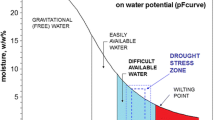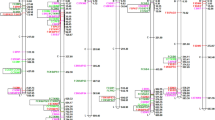Abstract
A quantitative genetics approach was developed to identify the genomic regions that control relative water content (RWC) in field-grown barley. The trait was previously demonstrated to be a relevant screening tool of drought-tolerance in cereals, as well as a good indicator of plant water-status. The trait was measured at the heading stage on flag leaves recorded from 167 recombinant inbred lines grown in several Mediterranean sites (Montpellier, France; Meknès, Morocco; Le Kef, Tunisia). The results obtained confirmed that several genomic regions are implicated in the total phenotypic variation of RWC. A total of nine chromosomal regions were identified. One region situated on the long arm of chromosome 6H contains the most-consistent QTL obtained in the present study. This region was previously identified as controlling RWC, as well as leaf osmotic potential under water stress and osmotic adjustment, from an experiment conducted in growth-chamber conditions with the same genetic background. The confirmation of the role of this region in the genetic control of water and turgor status underlined its interest for breeding purposes in the Mediterranean area. In addition, the presence of several dehydrin loci in the same chromosomal area reinforce its interest for genomics analyses to confirm, or not to confirm, the implication of these genes in the variation of RWC.


Similar content being viewed by others
References
Acevedo E (1987) Assessing crop and plant attribute for improvement in water-limited Mediterranean environments. In: Srivastava JP, Proceddu E, Acevedo E, Varma S (eds) Drought-tolerance in winter cereals. Chichester, John Wiley and Sons, pp 303–320
Arnau G, Monneveux P (1995) Physiology and genetics of terminal water-stress tolerance in barley. J Genet Breed 49:327–332
Barrs HD, Watherley PE (1968) A re-examination of the relative turgidity technique for estimating water deficit in leaves. Aust J Biol Sci 15:413–428
Blum (1989) Osmotic adjustment and growth in barley genotypes under drought stress. Crop Sci 29:230–233
Campbell SA, Close TJ (1997) Dehydrins: genes, proteins, and associations with phenotypic traits. New Phytol 137:61–74
Close TJ (1996) Dehydrins: emergence of a biochemical role of a family of plant dehydration proteins. Physiol Plant 97:795–803
Close TJ (1997) Dehydrins: a commonalty in the response of plants in dehydration and low temperature. Physiol Plant 100:291–296
Close TJ, Kortt A, Chandler PM (1989) A cDNA-based comparison of dehydration-induced proteins (dehydrins) in barley and corn. Plant Mol Biol 13:95–108
Courtois B, McLaren G, Sinha PK, Prasad K, Yadav R, Shen L (2000) Mapping QTLs associated with drought avoidance in upland rice. Mol Breed 6:55–66
Farquhar GD, Richards RA (1984) Isotopic composition of plant carbon correlates with water-use-efficiency of wheat genotypes. Aust J Plant Physiol 11:539–552
Haley CS, Knott SA (1992) A simple regression method for mapping quantitative trait loci in line crosses using flanking markers. Heredity 69:315–324
Ismail AM, Hall AE, Close TJ (1999) Allelic variation of a dehydrin gene cosegregates with chilling tolerance during seedling emergence. Proc Natl Acad Sci USA 93:13566–13570
Joshi CP, King SW, Nguyen HT (1992) Molecular cloning and caracterisation of a cDNA encoding a water stress protein (WSP23) from wheat roots. Plant Sci 86:71–82
Koag MC, Fenton RD, Wilkens S, Close TJ (2003) The binding of Maize DHN1 to lipid vesicles. Gain of structure and lipid specificity. Plant Physiol 131:309–316
Kunzel G, Korzum L, Meister A (2000) Cytologically integrated physical map for the barley genome based on translocation breakpoints. Genetics 154:397–412
Lafitte R, Courtois B (1999) Genetic variation in performance under reproductive-stage water deficit in a double-haploid rice population in upland fields. In: Ribaut JM, Poland D (eds) Molecular approaches for genetic improvement of cereals for stable production in water-limited environments. CIMMYT, El Batan, Mexico 21–25 June 1999, pp 97–102
Lilley JM, Ludlow MM, McCouch SR, O'Toole JC (1996) Locating QTLs for osmotic adjustment and dehydration tolerance in rice. J Exp Bot 47:1427–1436
Matin MA, Brown JH, Ferguson H (1989) Leaf water potential, relative water-content, and diffusive resistance as screening techniques for drought resistance in barley. Agron J 81:100–105
Martin M, Morgan JA, Zerbi G, LeCain DR (1997) Water stress rate effects on osmotic adjustment and cell-wall properties in winter wheat. Italian J Agron 1:11–20
Merah O (2001) Potential importance of water-status traits for durum wheat improvement under Mediterranean conditions. J Agric Sci 137:139–145
Pan A, Hayes PM, Chen F, Chen THH, Blake T, Wright S, Karsai I, Bedo Z (1994) Genetic analysis of the components of winter hardiness in barley (Hordeum vulgare L.). Theor Appl Genet 89:900–910
Peltonen-Sainio P, Makela P (1995) Comparison of physiological methods to assess drought-tolerance in oats. Acta Agri Scand 45:32–38
Price A, Courtois B (1999) Mapping QTLs associated with drought resistance in rice: progress, problems and prospects. Plant Growth Reg 29:123–133
Price AH, Townend J, Jones MP, Audebert A, Courtois B (2002) Mapping QTLs associated with drought avoidance in upland rice grown in the Philippines and West Africa. Plant Mol Biol 48:683–695
Ribaut JM, Edmeades G, Perotti E, Hoisington D (1999) QTL analyses, MAS results, and perspectives for drought-tolerance improvement in tropical maize. In: Ribaut JM, Poland D (eds) Molecular approaches for genetic improvement of cereals for stable production in water-limited environments. CIMMYT, El Batan, Mexico 21–25 June 1999, pp 131–136
Sandhu D, Gill KS (2002) Gene-containing regions of wheat and the other grass genomes. Plant Physiol 128:803–811
SAS Institute (1987) SAS/STAT guide for personal computers, 6th edn. SAS Institute, Cary, North Carolina
Schonfeld MP, Richard JC, Carver BF, Mornhi NW (1988) Water relations in winter wheat as drought resistance indicators. Crop Sci 28:526–531
Sinclair TR, Ludlow MM (1985) Who taught plants thermodynamics? The unfulfilled potential of plant water potential. Aust J Plant Physiol 12:213–217
Singh J, Patel AL (1996) Water-status, gas exchange, proline accumulation and yield of wheat in response to water deficit. Ann Biol 12:77–81
Tahara M, Carver BF, Johnson RC, Smith EL (1990) Relationship between relative water-content during reproductive development and winter wheat grain yield. Euphytica 49:255–262
Teulat B, Rekika D, Nachit MM, Monneveux P (1997a) Comparative osmotic adjustments in barley and tetraploid wheats. Plant Breed 116:519–523
Teulat B, Monneveux P, Wery J, Borries C, Souyris I, Charrier A, This D (1997b) Relationships between relative water-content and growth parameters under water stress in barley: a QTL study. New Phytol 137:99–107
Teulat B, This D, Khairallah M, Borries C, Ragot C, Sourdille P, Leroy P, Monneveux P, Charrier A (1998) Several QTLs involved in osmotic-adjustment trait variation in barley (Hordeum vulgare L.). Theor Appl Genet 96:688–698
Teulat B, Borries C, This D (2001a) New QTLs identified for plant water-status, water soluble carbohydrate and osmotic adjustment in a barley population grown in a growth-chamber under two water regimes. Theor Appl Genet 103:161–170
Teulat B, Merah O, Souyris I, This D (2001b) QTLs for agronomic traits from a Mediterranean barley progeny grown in several environments. Theor Appl Genet 103:774–787
Teulat B, Merah O, Sirault X, Borries C, Waugh R, This D (2002) QTLs for grain carbon-isotope discrimination in field-grown barley. Theor Appl Genet 106:118–126
Tinker NA, Mather DE, Rossnagel BG,Ksha KJ, Kleinhofs A, Hayes PM, Falk DE, Ferguson T, Shugar LP, Legge WG, Irvine RB, Choo TM, Briggs KG, Ullrich SE, Franckowik JD, Blake TK, Graf RJ, Dofing SM, Saghai Maroof MA, Scoles GJ, Hoffman D, Dahleen LS, Kilian, Chen F, Biyashev RM, Kudrna DA, Steffenson BJ (1996) Regions of the genome that affect agronomic performance in two-row barley. Crop Sci 36:1053–1062
Tinker NA, Mather DE (1995a) Methods for QTL analysis with progeny replicated in multiple environments. J Agric genomics 1:article 1
Tinker NA, Mather DE (1995b) Software for simplified composite interval mapping of QTL in multiple environments. J Agric genomics 1: article 2
Turner NC (1997) Further progress in crop water relations. Adv Agronomy 58:293–338
Turner NC, Jones MM (1980) Turgor maintenance by osmotic adjustment: a review and evaluation. In: Turner N, Kramer PJ (eds) Adaptation of plants to water and high temperature stress. Wiley, New York, pp 87–107
Utz HF, Melchinger AE (1995) PLABQTL—A computer program to map QTL: version 1.0. Institute of Plant Breeding, Seed Science and Population Genetics, University of Hohenheim, Stuttgart, 1995
Van Zee K, Qiang Chen F, Hayes PM, Close TJ, Chen THH (1995) Cold-specific induction of a dehydrin gene-family member in barley. Plant Physiol 108:1233–1239
Zhang J, Zheng HG, Aarti A, Pantuwan G, Nguyen TT, Tripathy JN, Sarial AK, Robin S, Babu RC, Nguyen BD, Sarkarung S, Blum A, Nguyen HT (2001) Locating genomic regions associated with components of drought resistance in rice: comparative mapping within and across species. Theor Appl Genet 103:19–29
Author information
Authors and Affiliations
Corresponding author
Additional information
Communicated by H. F. Linskens
Rights and permissions
About this article
Cite this article
Teulat, B., Zoumarou-Wallis, N., Rotter, B. et al. QTL for relative water content in field-grown barley and their stability across Mediterranean environments. Theor Appl Genet 108, 181–188 (2003). https://doi.org/10.1007/s00122-003-1417-7
Received:
Accepted:
Published:
Issue Date:
DOI: https://doi.org/10.1007/s00122-003-1417-7




